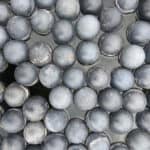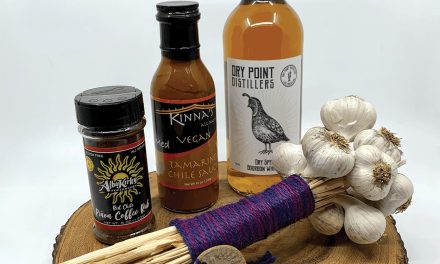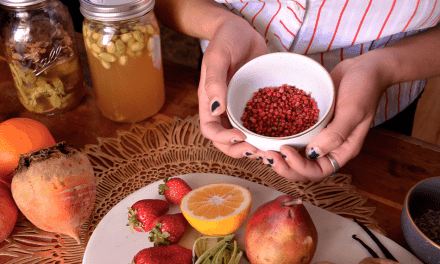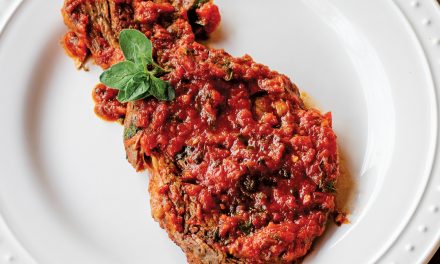By Christie Green

Sheep hide stretched for tanning in the field at Chispas Farm. Photo by Stephanie Cameron.
Clothing, like food, is a powerful cultural artifact that expresses values, religion, ritual, celebration, and ceremony. While both what we wear and what we eat are practical and necessary elements of everyday life, they also demonstrate who we are, where we live, and what we believe in.
But how, explicitly, do food and fashion intersect? Is clothing merely a product (or by-product) of the agricultural industry, or can there be a more profound connection between the apparel we wear and the plants and animals that sustain us?
Recognized designers consider the meaning of fashion as something beyond practical provision. Coco Chanel reflected, “Fashion is not something that exists in dresses only. Fashion is in the sky, in the street, fashion has to do with ideas, the way we live, what is happening.” Marc Jacobs sees fashion as identity: “To me, clothing is a form of self-expression—there are hints about who you are in what you wear.”

Suit with elk fur and ivory accents and blouse with elk heart–inspired fabric—designed by Christie Green, sewn by Lorraine Gruys, photo by Peter Ogilvie.
In my hunting practice, I honor the animals through continued connection by making use of select parts of their bodies. Bone, hair, and hoof—they are more than sustenance. Today, after two days of butchering, transforming a five-hundred-pound cow elk from hoofed body into future food, I feel her remaining weight as I heave her onto the countertop, a mass of matted tawny beige and blonde, long strands of deep umber and swaths of short, dense black.
Now her hide is ready to be fleshed and tanned. I kept her folded into a thick bundle on a wooden stool at the side of my bed through the night. I wanted her to dream me from darkness into light, as if she could be my liminal steward as I was hers when I pulled the trigger at meadow’s edge. This morning, when I carry her heavy skin from bedroom to kitchen, I ask where she grazed, what shadows the moon revealed in the timbers. I ask what to do with her coat that sheltered her through the changing seasons of her life. Her bones, too, and curved collagen hooves now rest on the portal roof as offerings to ravens and vultures, sparrows and thrashers, wriggling worms and shiny, shelled decomposer beetles. “What shall your body become?” I ask her.


Right: Patricia Michaels design, photo by Bill Curry. Left: Patricia Michaels design, photo by Jusua Tso.
As a new artist in the fashion design field, I recognize that the earliest clothiers were Indigenous, originating—and designing—centuries before modern-day runways, boutiques, and ateliers, long before Chanel and Jacobs, Ralph Lauren, Donatella Versace, Christian Dior, Jil Sander, Jeremy Scott, Alexander McQueen, and Vera Wang became household, and elevated, names.
“Of course, Indians invented fashion. Because everyone was just running around naked. They didn’t have no clothes. But first they invented the bow. Fashion accentuated survival,” asserts Marcus Amerman, an Indigenous designer originally from the Choctaw Nation of Oklahoma who is now based in Santa Fe. An iconoclast, Amerman works with many media, but is especially known for his beadwork. He is recognized as an artist who juxtaposes traditional materials and techniques with new forms that directly challenge stereotypes of Indigenous identity and boldly heighten awareness of sociopolitical issues.
Along with local Indigenous designers Patricia Michaels and Orlando Dugi, Amerman is exploring definitions of and inspirations for Native American fashion for a panel hosted by SITE Santa Fe and moderated by Amber-Dawn Bear Robe, professor, art historian, and curator of the Southwestern Association for American Indian Arts Fashion Show, a feature event at Indian Market since 2014.
“I consider Indigenous designers as the original couturiers of Native North America,” Bear Robe says during her introduction to the artists. “You do not get much more couture than, for example, going and killing the walrus, gutting the walrus, cleaning the intestines and, with absolute engineering, skill, and technique, stitching the walrus intestines together to not only make a beautifully stunning, aesthetically amazing piece but also [something] life-saving, protecting you from the elements. And that really represents the diversity of Native North American design.”
Bear Robe reminds us that contemporary Indigenous designers, while developing clothing grounded in landscapes, techniques, and materials of home, are continually evolving their expression with clothing that defies stereotypes and ideological boundaries. “There’s this idea that Native North Americans are buckskin, beads, and leather, and that’s the way we want our Indians to stay. It’s very complicated because Native Americans used to be a national identity marker for America for the rest of the world. The reality is culture—period—not just Indigenous culture, but culture globally is constantly changing. It is a living entity. Culture is living and growing and changing with the world around it.”
Patricia Michaels, of Taos Pueblo and Santa Fe, says, “That’s what we do as Native American designers. We are taking what resources we have and we are pulling [them] to the fullest forefront of our expression.”
When Michaels and I speak, she tells me, “The fabrics are about the hunters and gatherers that we are. If you respect your sanctuary, it’s deeper than just being food. To us, it’s something you bring into your house that nurtures and provides. So, making a garment with the wild plums and wild berries has huge meaning around it.”
I mention Bear Robe’s statement that “every garment tells a story,” and ask Michaels whether her clientele are interested in those stories. Lighting up, she says, “There’s an evolution that’s happened where people want to be part of the meaning of what they’re putting on. Everything we wear has a meaning.”
Michaels named her company, PM Waterlily, for her Native name, and her hand-painted fabrics embrace inspiration from native plants and edibles, micaceous soil, and Pueblo architecture. She repurposes leather in some of her jewelry and creates art for interior spaces from her fabric creations. Her textile palette and sensuous, earthly shapes and textures transport the viewer and wearer to magic stands of aspen forests, graceful arcs of eagle feathers, and micropatterns of roots, fungi, and celestial skyscapes.
Likewise, Orlando Dugi draws on his childhood growing up Diné, surrounded and supported by his grandmothers, with reverence for the landscape and expanse of stars above. The complex and intricate beadwork in his garments is created with a contemporary flair and new interpretation of his heritage. In the short documentary film Becoming: Orlando Dugi, Dugi reflects on the influence of plant life in his work. “I’ve been thinking of farming and gardening a lot lately. I use a lot of floral motifs. When you look through a garden, you really look at the stems, the plants, how they really curl around something. It’s really beautiful to see. So, I like to mix those kinds of things into my work.”
~
The animals I hunt and their habitats are the inspiration for my launch into fashion design. Nature, the wisest designer, informs the shapes, textures, and movement of the garments.
With the knives in place on the kitchen counter, I heave the elk hide onto the tile, fur side down. I peel the folds back to reveal the underside of her skin, still fresh and moist, dotted with Ponderosa needles, specks of soil, and tiny blades of dormant grass from where she lay as I dressed and quartered her near Cabresto Creek north of Questa.
Years ago, as a college student, I learned the craft of fleshing hides at a hunting lodge in my home state of Alaska. There I would process caribou, bear, moose, and Dall sheep. The skills I learned thirty years ago remain relevant, vivid. Today I clean and prepare the hides of elk, deer, and oryx. They have become material stories that grace the back of the couch, the office chair, and bancos in our home.
The cutting is slow, methodical, meticulous. I place one hand beneath the hide to feel its thickness and know how light or heavy a cut needs to be. The skin at the neck and rump is much thicker, tougher than the thin, tender skin at the belly. The health of this elk is palpable; her gleaming plump tissue and substantial, dense hair feel alive in my palms. I will get to know her intimately, from the inside out, as I continue slicing away meaty tissue to prepare her for tanning.
~
“They all go to the dump,” the woman at A&M Meat Processing in Alamogordo tells me. “Yeah, about fifteen cowhides a week and about eight hundred to nine hundred wild game hides a month during hunting season. They all get tossed. Unless a hunter wants to keep one.”
“You mean the hides that could be processed into leather are thrown away?” I ask.
“Yes,” she says, explaining, “there’s no tannery here or way to process them.”
So where do leather crafters like Dwight Lamberson of DL Leather-Works in Albuquerque source their materials?
“I buy leather from a lot of distributors. I really have no idea where it comes from,” says Lamberson, who resuscitated his love and practice of leather crafting about five years ago, making all kinds of pieces including handbags, wallets, and belts. “Small beef processors have no outlet. Much of the leather comes from Mexico, Europe, and Brazil.”
A by-product of the food industry, leather is a $100 billion worldwide trade. Although leather use dates back at least four hundred thousand years, most of the leather shoes, jackets, and armchairs that humans wear and use today are made from hides produced in places and ways that have no personal or geographic connection to the wearer. In 2016, the United States produced over thirty million hides from cattle, about four million pigskins, and just over two million sheep and goat hides.
R. L. Cox, an Albuquerque company specializing in leather and fur products since the 1920s, offers raw leather made from cow, lamb, pig, sheep, deer, and elk, as well as fox, coyote, bobcat, and other furs. While most of the leather and fur materials are shipped from within the United States, some are imported from countries such as Tibet, Iceland, and New Zealand. Co-owner Ellen Goodson describes the vast uses of various leathers, from crafts and clothing to moccasins, purses, and traditional Native American regalia. Whether traditional or contemporary, leather persists as a staple fashion foundation—which makes it all the more stunning that so many hides are wasted rather than integrated into local supply chain economies.


Left: Seedpod wall hanging by Oropopo. Right: skirt saddle bracelets by Oropopo. Photos courtesy of Oropopo.
Still in my kitchen, I finish fleshing the elk’s hide, imagining how her meat will sustain me, how her body will adorn mine.
When the hide is ready, I sprinkle coarse salt on it, covering all areas and rubbing it in as I go. This will help draw out moisture and residual blood in preparation for shipping. To shield the hide from predators, wind, and direct sun, I lay large pieces of cardboard on top of the two freezers in the shade of the portal, then hoist the cleaned hide to the protected, elevated hideaway.
Over the course of about five to seven days, I check on the elk, continuing to rub salt on her surface and into all edges and crevices. Residual moisture drips down the surface of the freezers in sinuous trails. Trickles of pale red fluid mixed with salt collect in crusty puddles on the portal floor.
Then, when she’s ready to be tanned, I crumple multiple wads of newspaper on her skin, roll her into herself, wrap the bundle with more newspaper, pack her in a box, and kiss her farewell as I ship her two states away.
~
Working out of their Albuquerque studio, Karole Mazeika and Grady Jaynes of Oropopo have been imagining and handcrafting leather wrist cuffs, earrings, necklaces, and sculptural pieces like seedpod wall hangings for seven years. Although the wife-and-husband team source their leather from a world-renowned company back east, rather than locally, they feel their work is rooted in place. Mazeika’s training as an architect and structural engineer influences the form and function of each piece. “While I really enjoyed it,” Mazeika says of her career in architecture, “I got a little frustrated not being able to actually build things. I learn on my own by making things with my hands.”
The pair’s distinctive, deeply contemporary work takes inspiration from the landscape. Milkweed, cottonwood, rain clouds, ocotillo, and oryx are among the New Mexico landscape features and animals that shape their line of laser-cut, hand-assembled leather.
The essence of veined leaves emanates from gold-dyed leather earrings, honoring the autumnal gilded glory of the bosque. Finely calculated curls of black-and-white leather mimic dramatic oryx horns, forming a striking blossom cluster of a necklace. “Each of our pieces has a story. And each is a form of celebration. Leather is the oldest material of self-adornment. . . . but with newer technology and imbuing it with place, site, time, and culture. We produce an ornament that has significance for the wearer beyond what we give it. Women feel that it is a shield, armor, a source of power. I love that,” beams Mazeika.




From top left, clockwise: Marissa Sieck tanning a sheep hide in the field at Chispas Farm; salted sheep, elk, deer, antelope, and goat pelts; sheep hide being tanned; Sieck with finished sheep hide. Photos by Stephanie Cameron.
“I’ve been asking questions like, ‘What is home? What is belonging? What are borders? What is land? What is stolen land? What is the world we live in?’ Coming into hide tanning has been a process of trying to understand what it means to be a visitor of this place and it’s been a practice of reparation,” Marissa Sieck shares on a call from Chispas Farm in Albuquerque’s South Valley.
Sieck has lived at the farm with their partner, and in community relationship with others who help there, for almost five years. More recently, they have begun to provide hand-tanning services and workshops in addition to co-stewarding the land they live on.
“We have dairy goats and a small herd of sheep,” Sieck says. “As I’ve been learning hide tanning, I have integrated meat and dairy and fiber animals on the farm. We have meat rabbits, so that’s the main process that I’m a part of. It’s like this death practice. We’ll share the meat with the people who take care of the land here, the farmers, and then anything left over we sell or give away.” Working with the farm’s domestic animals, Sieck tans hides for their use, to share with others and to sell. “People also come to me with domestic and wild hides. I’ll be working with a couple of teenagers who harvested an elk with a bow this past year. Eating that elk meat and tanning those hides will be such a wonderful experience.”
Sieck tells me that making connections with New Mexico ranchers and farmers through the practice of tanning has been an unexpected gift. “People will just reach out and tell me they’ve had these animal hides but didn’t know what to do with them. So I either teach them how to do it or do the tanning for them.” Reflecting on the unlikely intersections that have evolved through tanning, Sieck says, “It feels so connected and is a real bridge across identities and difference. I’m a nonbinary, queer, white settler and I get to just hang out with people who really love their animals and welcome me into their home. There’s a softening that happens through building relationships that way and I really love it.”
Sieck’s tanning workshops attract participants from many places and of diverse ages. “People come to the workshops, and everyone works on their own hide and then they take that home. These pieces bring their stories out. A lot of people who come are Diné. I try to provide a free workshop for everyone who needs a space. That feels important. . . . It has been a very emotional experience. I’ve found that people are showing up because they love their animals, or they didn’t have access to this kind of learning before. Grief around loss of who we are is evident.”
Although tanning is very much a hands-on, tactile, and utilitarian practice, Sieck emphasizes its significance, symbolism, and potential impact for meaningful healing. “There’s a slow rippling impact that I’m most interested in,” they say. “There are more hides than I can do as one person. This is rooted in mutual aid and community building. It’s a practice of how to do this in an anti-capitalistic way and support each other instead of being in competition.”
Roosters crow in the background as our call ends, and Sieck says something that will echo and reverberate inside me: “I can feel the sheep are taking care of me.”
~
Seven months later, the elk returns home from the tannery. Now she feels supple, like smooth, buttery suede. Her hair is clean, soft. Colors blend and converge like caramel ombré from her back to her rump and down her flanks. As I move my palms across her, I imagine again how I will wear her.
I decide on simple accentuation for a black tailored jacket and trousers. The elk will be the ultimate refinement for this classic silhouette. I craft textured earrings from fine strands of hair from her rump, held by shiny, silver hardware. The crimped tufts dangle from my ears, her hair tangling with mine.
Her two polished ivories (eyeteeth) punctuate the waistline of the pants, a shiny off-white contrast to the matte black. I select parts of her hide from her belly and neck to trim and tack onto the jacket lapels. Drilling holes into two of her toes, I sew them on the sleeves as mock cuff links. Lastly, a thin, round button honed from a scapula bone becomes the button on the front of the jacket.
To complement the ensemble, I design silk fabric for a deep red blouse whose print is imbued with the colors and textures of her heart—bruised blue, indigo, ripe scarlet. As I ease my arms into the sleeves and button the blouse around my chest, I feel the pulse of her, inside me.
She envelopes me, body to body, blending her story with mine.

Christie Green
Christie Green is a mother, hunter, and writer, and the principal landscape architect at radicle. Raised in Alaska and on her grandfather’s farm in West Texas, she now resides in Santa Fe. With food and water as catalysts, Green seeks to pique sensual connection and uncomfortable curiosity.















